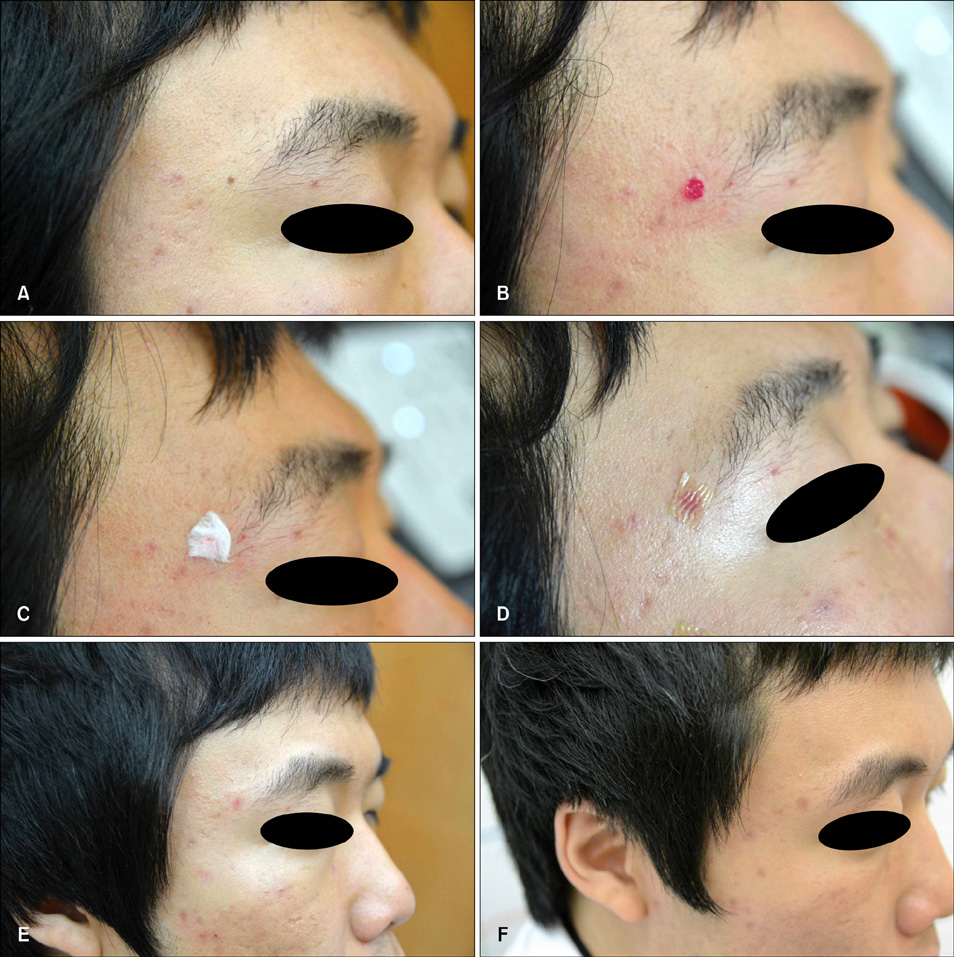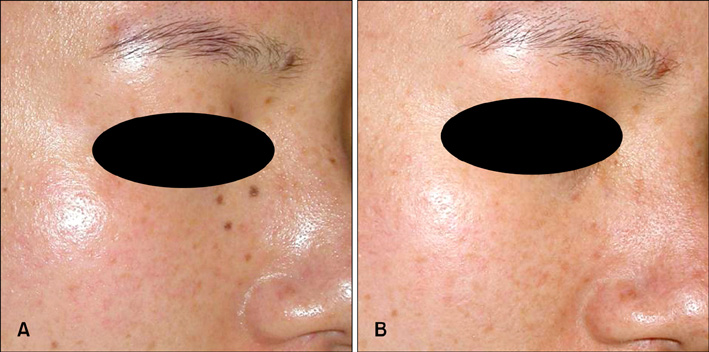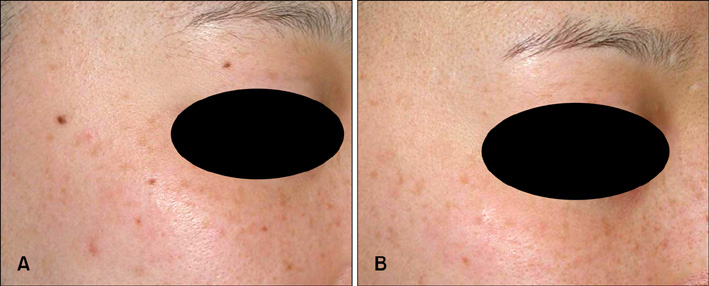Ann Dermatol.
2012 May;24(2):162-167.
Efficacy and Safety of 1,064 nm Q-switched Nd:YAG Laser Treatment for Removing Melanocytic Nevi
- Affiliations
-
- 1Department of Dermatology, College of Medicine, Soonchunhyang University, Seoul, Korea. snolomas@schmc.ac.kr
- 2CNP Skin Clinic, Cheoan, Korea.
Abstract
- BACKGROUND
Until recently, the removal of melanocytic nevi has been performed with a CO2 laser or Er:YAG laser. These lasers have been useful for removing affected spots. However, enlargement of spots or some sequelae, including depressed or hypertrophic scars, could develop as unwanted results. The Q-switched Nd:YAG laser has been used to remove deep-seated melanocytes, such as Ota nevus or tattoos. However, there have been no previous experiments performed to test the efficacy and safety of this laser treatment for melanocytic nevi.
OBJECTIVE
The objective of this study was to investigate the efficacy and safety of the 1,064 nm Q-switched Nd:YAG laser for removing melanocytic nevi, including congenital nevomelanocytic and acquired nevomelanocytic nevi.
METHODS
Two thousand and sixty four Korean patients with small melanocytic nevi were treated with a Q-switched Nd:YAG laser from 2005 to 2009. High-resolution photographs were taken in identical lighting and positions before and after the six weeks of treatment to observe the procedural efficacy.
RESULTS
About 70% of the nevi treated using a 1,064 nm Q-switched Nd:YAG laser were completely removed after one session. The other 30% were completely treated within three sessions. The appearance of sequelae such as hollow scars noticeably decreased compared to the results seen in CO2 or Er:YAG laser treatments.
CONCLUSION
Use of the 1,064 nm Q-switched Nd:YAG laser is a safe and effective treatment modality for melanocytic nevi.
Keyword
MeSH Terms
Figure
Reference
-
1. Stratigos AJ, Dover JS, Arndt KA. Laser treatment of pigmented lesions--2000: how far have we gone? Arch Dermatol. 2000. 136:915–921.2. Alster TS, Lupton JR. Laser therapy for cutaneous hyperpigmentation and pigmented lesions. Dermatol Ther. 2001. 14:46–54.
Article3. Anderson RR, Parrish JA. Selective photothermolysis: precise microsurgery by selective absorption of pulsed radiation. Science. 1983. 220:524–527.
Article4. Chan HH, Alam M, Kono T, Dover JS. Clinical application of lasers in Asians. Dermatol Surg. 2002. 28:556–563.
Article5. Chan HH, Ying SY, Ho WS, Kono T, King WW. An in vivo trial comparing the clinical efficacy and complications of Q-switched 755 nm alexandrite and Q-switched 1064 nm Nd:YAG lasers in the treatment of nevus of Ota. Dermatol Surg. 2000. 26:919–922.
Article6. Polnikorn N, Tanrattanakorn S, Goldberg DJ. Treatment of Hori's nevus with the Q-switched Nd:YAG laser. Dermatol Surg. 2000. 26:477–480.
Article7. Cho SB, Kim JS, Kim MJ. Melasma treatment in Korean women using a 1064-nm Q-switched Nd:YAG laser with low pulse energy. Clin Exp Dermatol. 2009. 34:e847–e850.
Article8. Cho SB, Park SJ, Kim MJ, Bu TS. Treatment of acquired bilateral nevus of Ota-like macules (Hori's nevus) using 1064-nm Q-switched Nd:YAG laser with low fluence. Int J Dermatol. 2009. 48:1308–1312.
Article9. Cho SB, Park SJ, Kim JS, Kim MJ, Bu TS. Treatment of post-inflammatory hyperpigmentation using 1064-nm Q-switched Nd:YAG laser with low fluence: report of three cases. J Eur Acad Dermatol Venereol. 2009. 23:1206–1207.
Article10. Kim SD, Kim SW, Huh CH, Suh DH, Eun HC. Changes of biophysical properties of the skin measured by non-invasive techniques after Q-switched Nd-YAG laser therapy in patients with nevus of Ota. Skin Res Technol. 2001. 7:262–271.
Article11. Anderson RR. Arndt KA, Dover JS, Olbricht SM, editors. Laser-tissue interactions in dermatology. Lasers in cutaneous and aesthetic surgery. 1997. Philadelphia: Lippincott-Raven;25–32.12. Anderson RR, Margolis RJ, Watenabe S, Flotte T, Hruza GJ, Dover JS. Selective photothermolysis of cutaneous pigmentation by Q-switched Nd:YAG laser pulses at 1064, 532, and 355 nm. J Invest Dermatol. 1989. 93:28–32.
Article13. Rosenbach A, Williams CM, Alster TS. Comparison of the Q-switched alexandrite (755 nm) and Q-switched Nd:YAG (1064 nm) lasers in the treatment of benign melanocytic nevi. Dermatol Surg. 1997. 23:239–244.
Article
- Full Text Links
- Actions
-
Cited
- CITED
-
- Close
- Share
- Similar articles
-
- To What Depth Is a Congenital Melanocytic Nevus Affected by 84 Pigment Laser Treatments?
- Effective Treatment of Suspicious Riehl's Melanosis Using Low Fluence 1,064 nm Q-switched Nd:YAG Laser and 595 nm Pulsed Dye Laser
- Beneficial Effect of Low Fluence 1,064 nm Q-Switched Neodymium:Yttrium-Aluminum-Garnet Laser in the Treatment of Senile Lentigo
- Treatment of Melasma with the Photoacoustic Twin Pulse Mode of Low-Fluence 1,064 nm Q-Switched Nd:YAG Laser
- Partial Unilateral Lentiginosis Successfully Treated with a High-fluence 1,064-nm Q-switched Neodymium:Yttriumaluminum-garnet Laser




